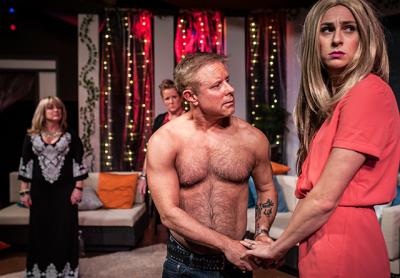LaBute's 'Money Shot': People at Their Worst

Two decades ago, Neil LaBute emerged on the scene with “In the Company of Men,” a movie taken from his earlier play, with a plot featuring the callous seduction of a deaf woman. The film received a number of awards and distinctions, and it launched him as an enfant terrible who went out of his way to say the heretofore unsayable.
In 2017, a reality star is in the White House, and much of what might have been startling in the way of manners and actions back then barely raises an eyebrow. Mr. LaBute’s 2014 play, “The Money Shot,” now on stage at the Southampton Cultural Center, no longer seems transgressive or shocking, but more a reflection of its times.
The film version of “Company of Men” did not predate reality television in 1997. But the play, written in 1992, dovetails exactly with the airing of “The Real World” series on MTV. The show, with its tag line “What happens when people stop being polite and start getting real,” began airing the same year, and did have characters who said what was on their mind, no matter how politically incorrect or hurtful.
A few years later the reality genre skyrocketed, with competition shows such as “Survivor,” “The Bachelor,” and, yes, “The Apprentice,” as well as the celebrities-at-home variants like “The Osbournes,” “Newlyweds: Nick and Jessica,” “Keeping Up With the Kardashians,” and all those many “Real Housewives.”
These shows have made their mark by showcasing people at their worst: callous, self-centered, greedy, backstabbing, vain, demanding, entitled. After so many years of witnessing this bad behavior, not only has public comportment coarsened, but our expectations of real and fictional conduct have, too.
So what does outlandish behavior look like in 2017? What it looks like in this play from three years ago is startlingly prescient. When Steve, a brash and full-of-himself action film star played by Joseph Marshall, questions the veracity of facts retrieved by Google because they prove that his own far-fetched notions are wrong, the situation seems all too familiar in this age of fake news‚ or accusations thereof.
Bonnie Grice plays Karen, a fading film star who has made a brand of herself by marketing her lifestyle through a blog and cookbooks. The spokeswoman for all manner of products and causes, she too seems a commonplace amalgam of her 2017 counterparts.
Missy, who is married to Steve, is half his age and clearly has an eating disorder that he has encouraged so she can keep her youthful figure as she ages. She is the stand-in for the modern American woman who feels compelled to ensure her perfection through hair color and extensions, personal trainers, injectables, lasers, and — when all else fails — surgery. She clearly feels that her main purpose in life is to be looked at. In a wig, a romper, and sky-high heels, Tamara Salkin captures Missy’s essence and keeps the audience guessing with her dimly delivered but often truthful insights.
Mr. LaBute’s proxy in this play may be Bev, a film editor and the partner of Karen. A graduate of Brown University, she wears her intelligence as a badge as she airs her frustration with the lack of smarts on display in what she thinks of as her home. Karen, though, quickly reminds her that this is her house, not Bev’s. Bev is no hero, though. Her pride in her intellect and her resulting pomposity may be buried in such appearance-obsessed company, but it is there just the same.
Joan Lyons, the director, writes in the playbill that “The Money Shot” represents new territory for the theater group. Perhaps reflecting on the characters’ (mostly) one-dimensionality, she wonders whether “we are seeing the real personality and moral compasses of these four characters, or are we seeing an ‘act,’ a cloak to disguise who they really are, who they want us to see?”
The set, a patio overlooking downtown Los Angeles, seems an exact replica of the one used in the play’s off-Broadway run, at least in the furniture and its placement. It implies the outdoors, with square columns strewn with ivy and bridged with gossamer draperies. The modern dark brown rattan couch, lounge, and settee with their plump cushions and elaborate throw pillows look expensive, as does the name-brand vodka, which flows freely throughout the play.
The group is brought there for dinner and to discuss the next day’s scenes from Steve and Karen’s comeback film. Their experimental Belgian director wants to inject some reality into their sex scene, and they want their partners’ permission to proceed. In the first act, they seem to discuss everything but that, but later on the plot and their plan detonates, with an unexpected twist.
It is telling that East Coast critics, such as The New York Times’s Ben Brantley, were mostly underwhelmed by the play, whereas it was praised by Variety’s critic in Los Angeles. New York audiences no doubt found the vacuous self-absorption of the characters antithetical to their own more intellectualized narcissism, whereas Hollywood just can’t get enough of itself, even when its ideals are being condemned.
The play continues through Sunday.
